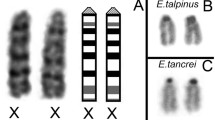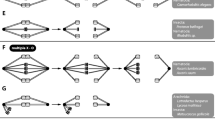Summary
The X-chromosome of the chinchilla is the largest member of the complement. Since its area equals approximately 9% of that of the haploid autosome set, it may represent a “duplicate-type X-chromosome”, in contrast to the “original-type” in which the ratio X:autosomes ranges from 5 to 6.5%. Unlike other known species with the “duplicate-type X-chromosome”, the chinchilla possesses a very small Y-chromosome.
It was inferred from the allocyclic behavior and asynchronous replication pattern of the sex chromosomes in somatic cells that one X-chromosome in the female and the male X-chromosome manifest a single genetically active region: the presumed active segment is inserted in the longer arm adjacent to the centromere. The remainder of these X-chromosomes, the entire second X-chromosome in the female and the Y-chromosome displayed positive heteropycnosis in mitotic prophase and completed DNA synthesis prior to mitosis later than any other elements: this cytologic behavior was held to reflect genetic inertness.
The existence of genetic inactivation of much of the “duplicate-type” X-chromosome mass of the chinchilla supports the hypothesis that a constant optimal ratio between the functional portion of the X-chromosomes and the autosomes is maintained in mammals despite a wide range of relative sizes of the X-chromosomes.
In female meiosis there is a free exchange of chiasmata between the X-chromosomes at first meiotic metaphase. In the male, however, the association between the large X- and small Y-chromosomes during meiosis is invariably end-to-end, denoting the absence of synapsis. This contrasts with the occurrence of side-by-side pairing of the XY-bivalent in other mammals possessing the “duplicate-type X-chromosome” but in which the Y-chromosome is correspondingly large.
Similar content being viewed by others
References
Barr, M. L.: The sex chromatin. In: Intersexuality (ed. C. Overzier), p. 48–71. New York: Academic Press 1961–1963.
Bennett, E. T.: On the Chinchillidae, a family of herbivorous Rodentia, and on a new genus referrible to it. Trans. zool. Soc. Lond. 1, 35–64 (communicated 1833; published 1835).
Beutler, E., M. Yeh, and V. F. Fairbanks: The normal human female as a mosaic of X-chromosome activity: studies using the gene for G-6-PD-deficiency as a marker. Proc. nat. Acad. Sci. (Wash.) 48, 9–16 (1962).
Eberle, P.: Comparative studies on sex chromosomes in different species. Genetica 35, 34–46 (1964).
Fredga, K., and B. Santesson: Male meiosis in the Syrian, Chinese, and European hamsters. Hereditas (Lund) 52, 36–48 (1964).
Galton, M., and S. F. Holt: DNA replication patterns of the sex chromosomes in somatic cells of the Syrian hamster. Cytogenetics 3, 97–111 (1964); - Asynchronous replication of the mouse sex chromosomes. Exp. Cell Res. 37, 111–116 (1965).
Hopkins, T. F., and L. M. Whidden: The demonstration of a sexual dimorphism in liver cells of the rodent Chinchilla laniger. Exp. Cell Res. 18, 178–179 (1959).
Hsu, T. C., W. Schmid and E. Stubblefield: DNA replication sequence in higher animals. In: Role of chromosomes in development (23rd Symp. Soc. Study Developm. Growth, ed. M. Locke), p. 83–112. New York: Academic Press 1964.
Huang, C. C., and L. C. Strong: Chromosomes of the African mouse. J. Hered. 53, 95–99 (1962).
Lyon, M. F.: Gene action in the X-chromosome of the mouse (Mus musculus L.). Nature (Lond.) 190, 372–373 (1961).
Makino, S.: Notes on the chromosomes of the porcupine and the chinchilla. Experientia (Basel) 9, 213–214 (1953a); - Chromosome numbers of some American rodents. Science 118, 630 (1953b).
Matthey, R.: Cytologie comparée des Cricetinae paléarctiques et américains. Rev. suisse Zool. 68, 41–61 (1961).
Moorhead, P. S., P. C. Nowell, W. J. Mellman, D. M. Battips, and D. A. Hungerford: Chromosome preparations of leukocytes cultured from human peripheral blood. Exp. Cell Res. 20, 613–616 (1960).
Nes, N.: The chromosomes of Chinchilla lanigera. Acta vet. scand. 4, 128–135 (1963).
Ohno, S., W. Beçak, and M. L. Beçak: X-autosome ratio and the behavior pattern of individual X-chromosomes in placental mammals. Chromosoma (Berl.) 15, 14–30 (1964).
, and T. S. Hauschka: Allocycly o the X-chromosomes in tumors and normal tissues. Cancer Res. 20, 541–545 (1960).
Ohno, S., and C. Weiler: Relationship between large Y-chromosome and side-by-side pairing of the XY-bivalent observed in the Chinese hamster, Cricetus griseus. Chromosoma (Berl.) 13, 106–110 (1962).
Osgood, W. H.: The technical name of the chinchilla. J. Mamm. 22, 407–411 (1941).
Saksela, E., and P. S. Moorhead: Enhancement of secondary constrictions and the heterochromatic X in human cells. Cytogenetics 1, 225–244 (1962).
Stern, C.: Dosage compensation — development of a concept and new facts. Canad. J. Genet. Cytol. 2, 105–118 (1960).
Taylor, J. H.: Asynchronous duplication of chromosomes in cultured cells of Chinese hamster. J. biophys. biochem. Cytol. 7, 455–464 (1960).
Thompson, J.: The XY-bivalent in Chinchilla laniger. Virginia J. Sci. 6, 53–55 (1955).
Wolf, U., G. Flinspach, R. Böhm u. S. Ohno: DNS-Reduplicationsmuster bei den Riesen-Geschlechtschromosomen von Microtus agrestis. Chromosoma (Berl.) 16, 609–617 (1965).
Author information
Authors and Affiliations
Additional information
Supported by USPHS research grants HD 00544, GM 10210 and CA 05138.
John and Mary R. Markle Scholar in Academic Medicine.
The authors gratefully acknowledge the valuable technical assistance of Miss Sarah F. Holt and Mr. Richard J. Low.
Rights and permissions
About this article
Cite this article
Galton, M., Benirschke, K. & Ohno, S. Sex chromosomes of the chinchilla: Allocycly and duplication sequence in somatic cells and behavior in meiosis. Chromosoma 16, 668–680 (1965). https://doi.org/10.1007/BF00285116
Received:
Published:
Issue Date:
DOI: https://doi.org/10.1007/BF00285116




